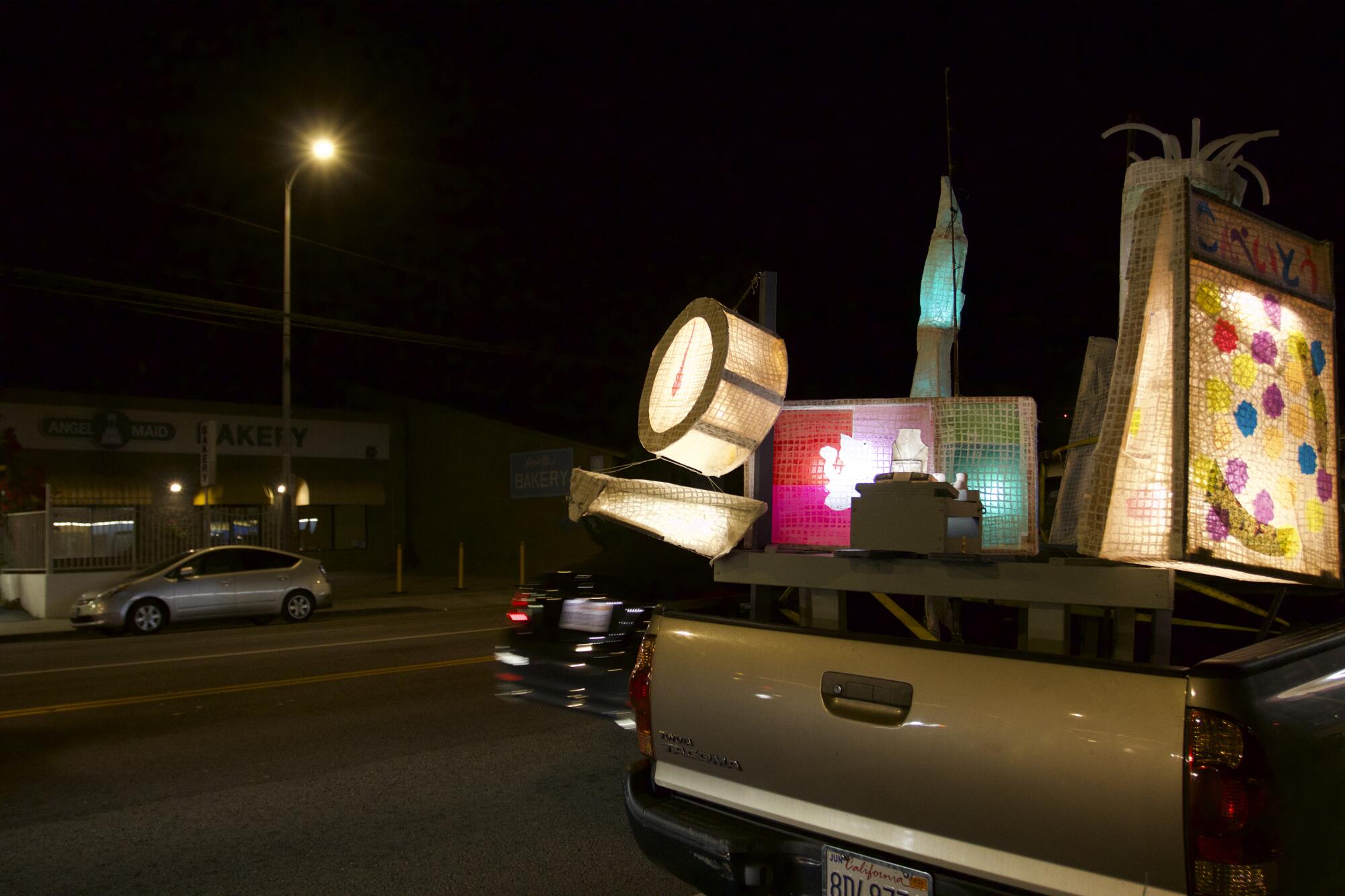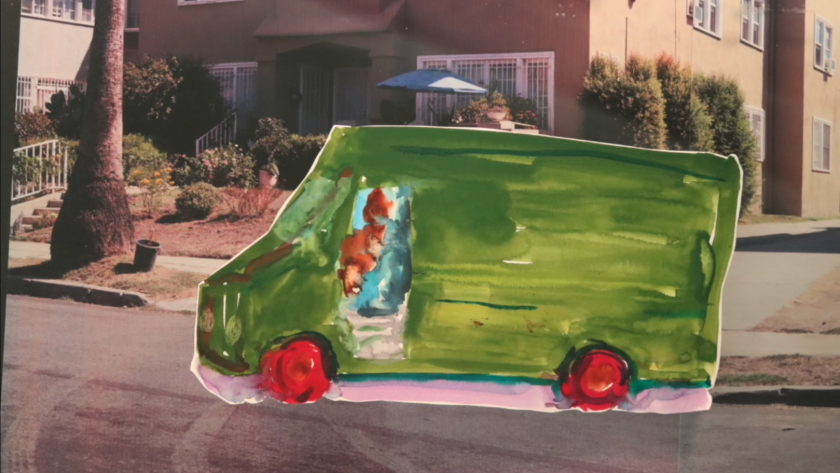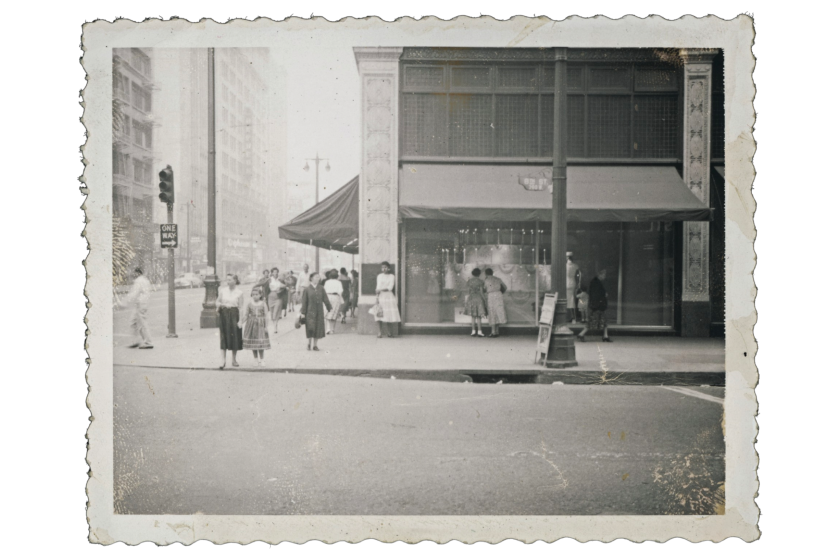- Share via
This story is part of Image Issue 16, “Interiority,” a living archive of L.A. culture, style and fashion that shows how the city moves from the inside. Read the whole issue here.
I was born and raised in what’s now Koreatown. Before it became Koreatown, it was, at least in my immediate neighborhood, packed with Japanese immigrants. But there were no Japanese markets, so there was this truck that would park literally across the street from our house and honk the horn. The truck was run by a Japanese man. I would go there with my grandmother; I was always enamored by the Japanese candy that was hanging on the shelves. It was as big as a UPS truck, but it was green. It had a center aisle and on both sides were shelves and cabinets. There were sinks with lots of crushed ice with seafood on it. You could get vegetables, rice, seaweed — pretty much what you would see at a Japanese market today — but it was all in this truck. Most of my memories are visceral. I remember the owner wearing an apron. I remember him wearing black rubber boots. I remember the scale — I was fascinated by the scale. I remember the smell of the fish.
The owner’s name was Mr. Hatakeyama. My mom saw him in Little Tokyo, a year or two before the pandemic. While putting this project together, I put the word out to my network of Japanese Americans saying I was looking for him. Then Leslie Ito, who is the director of the Armory Center for the Arts in Pasadena, emailed me and said, “I think there used to be a Hatakeyama at Nishi Buddhist Temple in Little Tokyo.” I emailed the Buddhist temple, and pretty immediately, they emailed back to say, “Well, there was this one Hatakeyama, but unfortunately he passed away last year.” They sent me a photo they had of him, and I immediately showed it to my mom — and it was him. We missed him by a year or so.
More stories from Interiority
rafa esparza on the story of ‘Corpo RanfLA: Terra Cruiser’
Sam Muller unpacks the oral history of Hollywood High 16
Julissa James examines the style legacy of Homies
Angela Flournoy talks to Robin Coste Lewis about ‘deep time’
Alan Nakagawa remembers the Japanese market on wheels
For this project, as I often do, I started with watercolors. I’m a sound artist, but I started as a visual artist. Drawing helps me kind of digest what I have — it’s like a map. As I did these watercolors, I remembered some of the objects I recalled in the truck. Eventually, I was thinking it’d be nice to have larger-than-life sculptures of these objects, so I decided to make them into lanterns.
The most repeated item was the Botan Rice Candy — it’s kind of a jelly square, but it’s wrapped in this see-through paper that’s edible, and then that’s wrapped in a wax paper. It’s like Cracker Jacks, in that there’s a toy inside. As a kid, it was probably the most fun item you could buy off the truck. I made a fish that looked sort of dehydrated — I was trying to allude to that dried seafood that we ate all the time watching TV. I made a big bag of rice. I had to make the scale. And daikon — I love daikon. I think it’s the funniest root vegetable. My grandfather used to pickle daikon in the garage that is now my recording studio. He used to have all these barrels in there and it smelled horrible — this vinegary, garbage smell. That’s where I make all my music.

We ended up popping the lanterns onto my truck and driving around Los Angeles to some of the neighborhoods where the various trucks went: K-town, Mar Vista, J flats in Hollywood, Boyle Heights, Crenshaw Square. Stephanie Aviles followed me and documented the whole thing. It was a beautiful kind of homage. Visually, it’s a beautiful thing to see all these weirdly shaped lanterns, driving through the city. In Japan, they have these big festivals where they have ginormous lanterns and they have taiko drumming, and they’re these big, old, heavy things and they put them on their shoulders — there could be 50 or 100 people carrying them around a village or town or city. I’m sure that influenced my direction on this as well.
Through the entire night, as I drove around L.A., I had a two-hour loop of Japanese pop tunes from the ’60s and ’70s playing on my car stereo. It felt like we were channeling the past — like we were traveling back in time to when the cohesion of this immigrant population was a little bit more visible.
Alan Nakagawa is an interdisciplinary artist with archiving tendencies, primarily working with sound, often incorporating various media and working with communities and their histories. His first book, “A.I.R.Head: the anatomy of an artist in residence” published by Writ Large Projects, maps his artistic trajectory that led to his nine artist residencies in six years. Nakagawa is a recipient of two Art Matters grants, City of Los Angeles Artist Fellowship, California Community Foundation Mid-Career Artist Fellowship and a Monbusho Scholar. @nakagawa2015
More stories from Image







